Previewing Maxiotek's MK8115 SSD Controller: Can DRAM-less Drives Make The Cut?
by Billy Tallis on May 9, 2017 8:00 AM ESTSequential Read Performance
The sequential read test requests 128kB blocks and tests queue depths ranging from 1 to 32. The queue depth is doubled every three minutes, for a total test duration of 18 minutes. The test spans the entire drive, and the drive is filled before the test begins. The primary score we report is an average of performances at queue depths 1, 2 and 4, as client usage typically consists mostly of low queue depth operations.
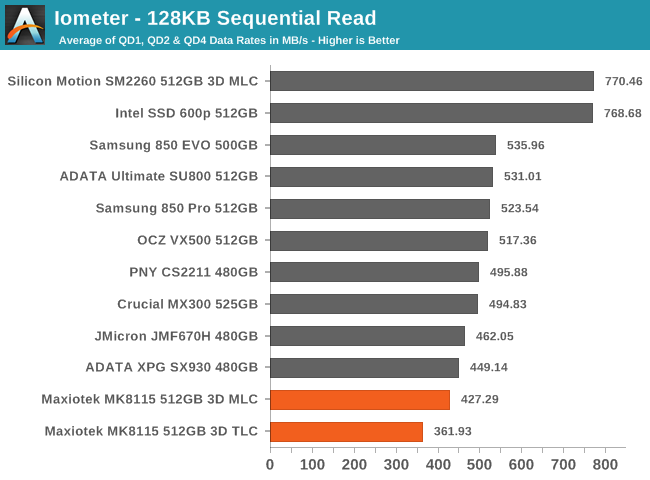
The two MK8115 drives land at the bottom of the performance rankings again for the sequential read test. They aren't really close to saturating the SATA 3 link at low queue depths, but both do at least offer significantly higher throughput than a SATA 2 link could provide, and the fact that the competition is limited by SATA 3 means the MK8115 drives fall behind by a smaller percentage than would otherwise be the case.
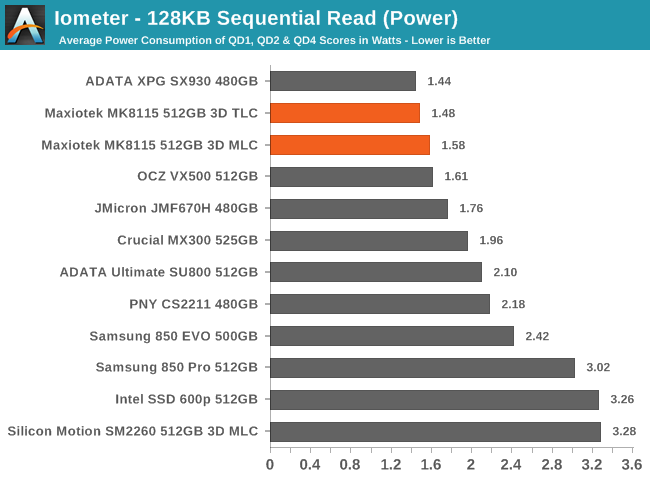
To go with their low performance the MK8115 drives offer almost the lowest power consumption, so the power efficiency is at least reasonable. The ADATA SX930 based on the JMicron JMF670H controller manages to deliver higher throughput with less power, so the lack of a DRAM cache seems to be hurting more than helping efficiency on this test.
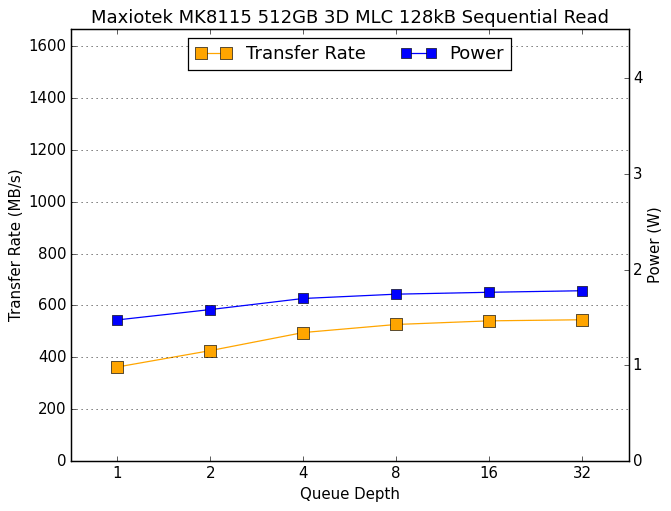 |
|||||||||
Like most SATA drives, the performance scaling as queue depth increases is mostly flat. There's slight performance growth all the up to QD16 while many SATA SSDs are able to offer their full sequential read throughput at QD2.
Sequential Write Performance
The sequential write test writes 128kB blocks and tests queue depths ranging from 1 to 32. The queue depth is doubled every three minutes, for a total test duration of 18 minutes. The test spans the entire drive, and the drive is filled before the test begins. The primary score we report is an average of performances at queue depths 1, 2 and 4, as client usage typically consists mostly of low queue depth operations.
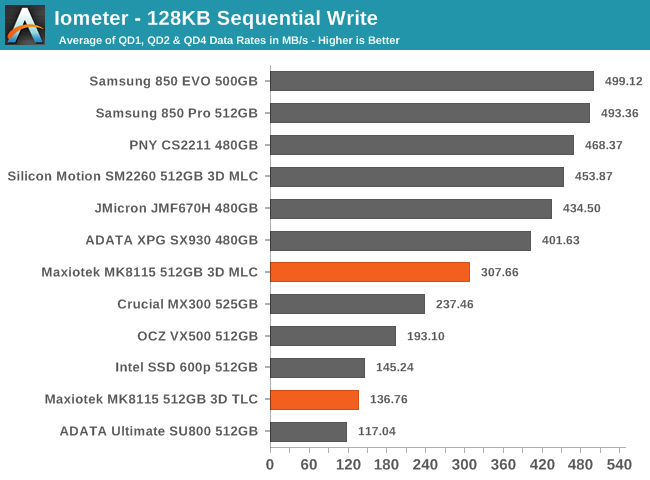
The sequential write test reveals one of the biggest gaps between the MLC and TLC based MK8115 drives. The TLC drive is almost the slowest drive on this test, but the MLC drive is more than twice as fast and outperforms most TLC SSDs while not quite matching typical MLC performance.
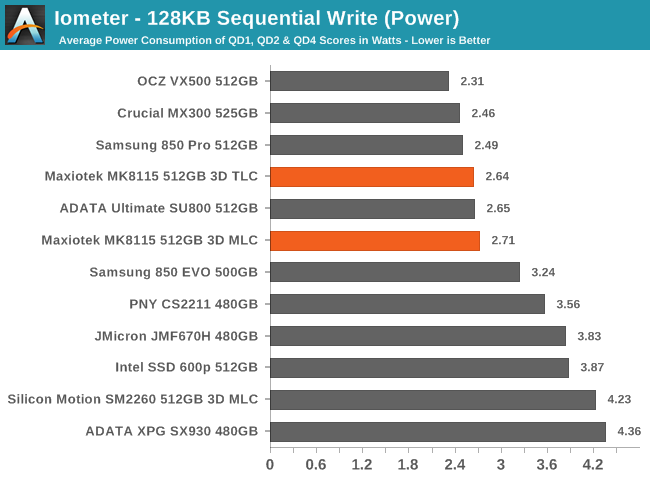
Both MK8115 drives had similar power consumption on the sequential read test, revealing the MLC drive to be far more efficient but still nothing great compared to the competition.
 |
|||||||||
The MK8115 drive with MLC experiences a bit of trouble near the middle of the sequential write test, as write speeds drop slightly, but by the end of the test they've mostly recovered and power consumption has been constant across queue depths.










60 Comments
View All Comments
romrunning - Tuesday, May 9, 2017 - link
Here's an example of performance regression - the Intel 600p versus any other Intel PCIe SSD (like the Intel 750 or P3700). Clear performance drop.Don't confuse it with price differences or target buyer - you only asked for an example of performance regression.
MajGenRelativity - Tuesday, May 9, 2017 - link
The 600p isn't even targeted at the same market segment. That's like saying that every single SSD released since the Intel P4800X is a performance regression because it can't come close to those random IOPS. I'm talking about a performance regression within the same price segment.CheapSushi - Wednesday, May 10, 2017 - link
The Intel 600P is TLC NAND and the Intel 750 is MLC NAND.... maybe you don't know the difference? TLC is inherently slower than MLC; 3 bits per cell vs 2 bits per cell.MajGenRelativity - Thursday, May 11, 2017 - link
A. I know the difference. B. MLC vs TLC isn't even the point. C. My point still stands because the 600p is not targeted at the high end.satai - Tuesday, May 9, 2017 - link
There are some cheap models and there some awesome models (Intel 750 and Intel Enterprise models, Samsung 960s, Optanes...). Pick yourself.MajGenRelativity - Tuesday, May 9, 2017 - link
The Intel Optane enterprise drive certainly is awesome, but I find it's price a bit hard to sell an average consumer on.melgross - Tuesday, May 9, 2017 - link
Well, all new technologies cost the most at first, and much less later. Performance is the opposite. The worst at first, and much better later.Next year, the price of Optane will be half of what it is now, but for a 512GB board, rather than the 375GB board it is now. Still expensive, sure. But you just have to learn to be patient.
WinterCharm - Tuesday, May 9, 2017 - link
On the bright side, Optane should be a lot cheaper to produce in the long run. While it's terrible as an accelerator, it's fantastic as a standalone drive. Prices will come down over time.CheapSushi - Wednesday, May 10, 2017 - link
Is the average consumer one that even reads about these things? The average consumer just goes to Best Buy and a salesman tells them what to get. Anyone who reads AnandTech and/or actually read the reviews about Optane aren't average consumers anyway.MajGenRelativity - Thursday, May 11, 2017 - link
True, but I doubt most of us still have the money for a $1,500 375GB SSD